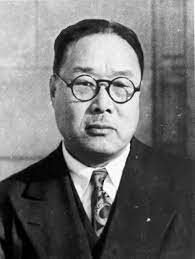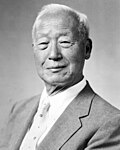
The history of South Korea begins with the Japanese surrender on 2 September 1945. At that time, South Korea and North Korea were divided, despite being the same people and on the same peninsula. In 1950, the Korean War broke out. North Korea overran South Korea until US-led UN forces intervened. At the end of the war in 1953, the border between South and North remained largely similar. Tensions between the two sides continued. South Korea alternated between dictatorship and liberal democracy. It underwent substantial economic development.

Syngman Rhee was a South Korean politician who served as the first president of South Korea from 1948 to 1960. Rhee is also known by his art name Unam. Rhee was also the first and last president of the Provisional Government of the Republic of Korea from 1919 to his impeachment in 1925 and from 1947 to 1948. As president of South Korea, Rhee's government was characterised by authoritarianism, limited economic development, and in the late 1950s growing political instability and public opposition.

The Korean Provisional Government (KPG), formally the Provisional Government of the Republic of Korea, was a Korean government in exile based in China during the Japanese occupation of Korea.

The First Republic of Korea was the government of South Korea from August 1948 to April 1960. The first republic was founded on 15 August 1948 after the transfer from the United States Army Military Government that governed South Korea since the end of Japanese rule in 1945, becoming the first independent republican government in Korea. Syngman Rhee became the first president of South Korea following the May 1948 general election, and the National Assembly in Seoul promulgated South Korea's first constitution in July, establishing a presidential system of government.

Constitutional Assembly elections were held in South Korea on 10 May 1948. They were held under the U.S. military occupation, with supervision from the United Nations, and resulted in a victory for the National Association for the Rapid Realisation of Korean Independence, which won 55 of the 200 seats, although 85 were held by independents. Voter turnout was 95%.

The April Revolution, also called the April 19 Revolution or April 19 Movement, were mass protests in South Korea against President Syngman Rhee and the First Republic from April 11 to 26, 1960, which led to Rhee's resignation.

Ji Cheong-cheon, also known as Yi Cheong-cheon, was a Korean independence activist during the period of Japanese rule (1910–1945). He later became a South Korean politician. His name was originally Ji Seok-gyu, but he took the nom de guerre Ji Cheong-cheon, meaning "Earth and Blue Sky", while leading Korean guerrilla forces against the Japanese. To hide his identity from Japanese forces while conducting military independence activities, he also used the names Ji Dae-hyoung, Ji Su-bong, and Ji Eul-gyu. His pen name was Baeksan, meaning White Mountain.

Chang Myon was a South Korean statesman, educator, diplomat, journalist and social activist as well as a Roman Catholic youth activist. He was the only prime minister of the parliamentary Second Republic. In addition, during the First Republic he was the fourth and last vice president of South Korea. His art name was Unseok (운석). His English name was John Chang Myon.

Yi Yun-young was an independence activist, educator, and Methodist minister during the Japanese occupation of Korea. His family clan originated in Danyang, and he was from Yongbyon in Pyonganbuk-do. His art name was Baeksa. During the March 1st Independence Movement, he was arrested for holding a lecture declaring independence and protesting against the Japanese occupation. In 1940, his pastoral qualifications were suspended because he opposed the unification of the churches in Korea and Japan and refused to adapt Sōshi-kaimei. After the Liberation, he participated with Cho Man-sik in the Committee for the Preparation of Korean Independence, founded the Korean Democratic Party, and was active as the party's vice leader. After his escape to the South, he was recommended as acting Prime Minister. After the establishment of Korea's government, he was named to be the first prime minister, but he was defeated because of the rejection of his confirmation by the Korea Democratic Party. After that, he was named to be the prime minister three more times, but each time he was rejected. Being one of Syngman Rhee's closest allies, he served as Minister without Portfolio and Minister of Social Affairs during the First Republic. He ran for vice president representing the anti-Lee Ki-poong faction but was defeated. After the May 16th Coup, he was Chairman of the Committee for Struggle against the prolongation of Military Government and executive member of the People's Party. He was an aide of Cho Man-sik, then after he defected to the South, he worked as an aide to Syngman Rhee.

Parliamentary elections were held in South Korea on 29 June 1960. They were the first and only direct elections of the Second Republic and saw the first election of members of the new House of Councillors, together with the fifth election of members of the House of Representatives. They were also the first relatively free and fair national elections held in the country, but would be the last free elections until the 1987 presidential elections. Voter turnout was 84.3%.
Indirect presidential elections were held in South Korea on 12 August 1960, which saw the election of Yun Posun as President of the Republic of Korea, a ceremonial political position in the Second Republic. Held after the April Revolution which had forced the resignation of Syngman Rhee, it was the only presidential election to be held during the short era of the Second Republic, as the Republic folded after Park Chung-hee's May Coup the next year. The election was indirect, with a joint session of the House of Commons and Senate, which had been elected in July, acting as the electors. The winning candidate required the assent of two thirds of the members of both houses.

Kim Young-sam, often referred to by his initials YS, was a South Korean politician and activist who served as the 7th president of South Korea from 1993 to 1998.

Sin Ik-hui was a Korean independence activist and politician. He was Speaker of the National Assembly during President Syngman Rhee's first term and second term.
The Korea Independence Party was a political party in South Korea.
Events from the year 1948 in South Korea.

The Democratic Party was a political party in South Korea. The party was the first truly organized liberal opposition against Syngman Rhee's conservative Liberal Party, and is considered as the predecessor to the lineage of the South Korean liberal parties.

The Korean National Revolutionary Party, or KNRP, was a nationalist party formed by exiles in Shanghai in 1935 to resist the Japanese occupation of Korea. At first it was the main nationalist Korean political party, but as the Sino-Japanese War (1937–45) progressed the rival Korean National Party, later Korea Independence Party, gained more influence with the Chinese Nationalist government in Chongqing and came to dominate the Korean Provisional Government. The KNRP of America was a significant factor as a source of funds and a link to the US government. The KNRP was dissolved in 1947.

Cho Bong-am was a South Korean independence activist and politician, who ran for president in the South Korean presidential election in 1956. He was a founding member of the Communist Party of Korea and the Progressive Party, a moderate socialist democratic party in South Korea which was one of the country's major political forces.
Elections to the Interim Legislative Assembly were held in South Korea in October 1946.

Im Yeong-sin, also known by the English name Louise Yim, was a South Korean educator and politician. She was both the first female minister in South Korea, holding the post of Minister of Commerce and Industry from 1948 to 1949, and the first woman elected to the South Korean parliament, serving from 1949 to 1954. Yim also helped establish Chung-Ang University.


















